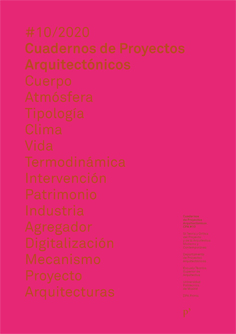The hidden geometry of MUSAC. Field systems as the origin of form in the contemporary project
DOI:
https://doi.org/10.20868/cpa.2020.10.4577Palabras clave:
Systems of field, Play rules, Geometry, Origin, Form, Project, MUSAC, Mansilla & TuñónResumen
Abstract
The origin of the contemporary project’s form has become an enigma. The process of drawing up a project ends up being a superimposed, diluted reality, hidden by the narratives constructed by their authors. At some point, in which the process becomes more important than the result itself, a ‘simulated’ story is apparently more conveyable than the process itself. In addition, multiple simultaneous approaches to the form reveal the complexity and diversity that an architect faces when undertaking a project. In this scenario, Luis Moreno Mansilla and Emilio Tuñón, the architects of the subject of this paper, state that in the face of processes of positivist identification, it is in the project’s requirements ( function, place, technique, budget, ...) that the argument and the formal interpretation of the modern project is born. It is in the oscillation processes, and in its starting mechanisms, determined by open and flexible systems, play rules and diagrams, that an abstract and generic form is generated, the origin of the contemporary project, which is later defined and limited by its contact with reality. The MUSAC’s architecture project is a current example of the work of these architects, where personal interests or private obsessions meet public needs, through field systems formed by local behaviour patterns and context logistics. The MUSAC, a case within the evolution of frames in the genealogy of mat-buildings, finds withing the field systems notion a set of play rules that allows growth, adaptability and transformation, as well as exception and singularity. This research makes a critical analysis of the “visible” geometry of the MUSAC by reconstructing a hypothetical project process, or a narrative constructed by the architects to justify the process, using the drawing as a tool capable of unveiling and decoding the different layers that gave form to the project.
Descargas
Referencias
ALLEN, Stan. “Distribuciones, Combinaciones, Campos (Notas preliminares hacia una logística del contexto)”, BAU nº14. Valladolid: C.O.A.C.L., 1996.
ALLEN, Stan. Stan Allen in conversation with Enrique Walker. Madrid: DPA, 2016.
ALTMAN, Ilana. “Expiry and expansion: Mansilla + Tuñón’s Unfinished architecture”. From Rules to constraints, edited by Giancarlo Valle, 80- 87. Hong Kong: Lars Müller publishers, 2012
ARETS, W. “Campos”, revista BAU nº14. Valladolid: C.O.A.C.L, 1996.
ARNEDO CALVO, Elena. Patrones repetitivos y modulares en la arquitectura española a partir de 1950, tesis doctoral, Madrid: UPM, 2016.
CAPITEL, Antonio. Metamorfosis de monumentos y teorías de la restauración. Madrid: Alianza Forma, 1988. COLL, Juan. “MAT BUILDING”, en Circo nº54, Madrid, 1998.
COLQUHOUN, Allan. “Interacciones formales y funcionales. Un estudio de los dos últimos proyectos de Le Corbusier”, en Arquitectura Moderna y cambio histórico: ensayos 1962-1976. Barcelona: GG, 1978.
CORTÉS, Juan Antonio “Geometrías activadas. La arquitectura de Mansilla+ Tuñón: una aproximación”. El Croquis nº161, Mansilla + Tuñón. In memoriam. Geometrías Activas, 6-31. Madrid: El Croquis, 2012.
DIAZ MORENO, Cristina. y GARCÍA GRINDA, Efrén. “Capacidades blandas y Disciplina: modo de empleo” (Entrevista a Luis Moreno Mansilla y Emilio Tuñón). Croquis 115/116 [II]. Madrid: El Croquis editorial, 2003. DIAZ MORENO, C. y GARCÍA GRINDA, E. “Una entrevista con Luis Moreno Mansilla y Emilio Tuñón”. Croquis 161, Mansilla + Tuñón. In memoriam. Geometrías Activas, 170-185. Madrid, El Croquis editorial, 2012.
FERNANDEZ GALIANO, Luis. “Tras el MIES al MUSAC, Mansilla y Tuñón, una conversación en Barcelona”, Arquitectura Viva nº111, 88, Madrid: AAVV, 2006.
FARINI ORLEANS BORBÓN, Elena. Procesos Configurativos. De la trama a la noción de campo en los mat-buildings. Tesis doctoral. Madrid: UPM, 2013.
GAUSA, Manuel, et al. Diccionario Metápolis de arquitectura avanzada. Barcelona:Actar,2001
GONZÁLEZ CRUZ, Alejandro., MARURI, Nicolás, y PINA, Rafael. “Las especies de Mansilla + Tuñón [1992- 2012]. Una aproximación al origen de la forma en el proyecto de arquitectura contemporáneo”, Revista de Arquitectura 25(38), 36-44. Chile: Universidad de Chile, 2020
MONEO, Rafael. “La vida de los edificios. Las ampliaciones de la Mezquita de Córdoba”, en Arquitectura nº256, 26-36. Madrid: C.O.A.M, 1985.
MONEO, Rafael. Inquietud teórica y estrategia proyectual. Barcelona: Actar, 2004.
MORENO MANSILLA, Luis. “Apuntes de viaje al interior del tiempo”. Colección Arquithesis nº10. Barcelona: Fundación Caja de Arquitectos, 2001.
MORENO MANSILLA, Luis y TUÑÓN, Emilio. “Arranque y oscilación. Embudos y duchas” Circo nº96. Madrid: CIRCO M.R.T., 2002.
MORENO MANSILLA, Luis. MUSAC. Seis paisajes, Conferencia celebrada en el Salón de actos de la ETSAM, como acto de clausura de las actividades de la Catedra Blanca durante el curso 2008-2009. (Madrid: Cátedra Blanca, 2009). Recuperado en https://www.youtube.com/ watch?v=hL-roLpnqLQ.
MORENO MANSILLA, Luis y TUÑÓN, Emilio. “Innovación y tradición en la arquitectura contemporánea: MUSAC. Seis paisajes”. Cuadernos de Proyectos Arquitectónicos nº1, 33-36. Madrid: DPA, ETSAM, 2010.
MORENO MANSILLA, Luis y TUÑÓN, Emilio. MUSAC. Six Landscapes. Conference in Avery Hall, Wood Auditorium. (New York: GSAPP, 2010). https://www.youtube.com/ watch?v=Rgvnx_YrO4k
MORENO MANSILLA, Luis y TUÑÓN, Emilio. “MUSAC Seis paisajes”. Circo nº218, Madrid, 2016.
RUIZ CABRERO, Gabriel. “Adiciones”, Circo nº17. Madrid: CIRCO M.R.T., 1994.
SMITHSONS, Allison& Peter. “How to recognize and read mat-building” en Architectural Design nº9, 573-590. (London: AD, 1974).
TUÑÓN, Emilio. “Campos de Columnas” (1996) en “Conceptos desplazados”, tesis doctoral de Emilio Tuñón, 141-160. (Madrid: UPM, 2000)
TUÑÓN, Emilio. “La geometría oculta de la memoria”, Circo nº111. Madrid: CIRCO M.R.T., 2003.
TUÑÓN, Emilio. MUSAC. Seis paisajes, Conferencia impartida en el Auditorio del MUSAC. León: MUSAC, 2019. Recuperado en:https:// www.youtube.com/ watch?v=HHzC30eqoSI
WALKER, Enrique. “Scaffoldings”, en From Rules to constraints, editado por Giancarlo Valle, 74-79. Hong Kong: Lars Müller publishers, 2012
Descargas
Publicado
Número
Sección
Licencia
1. Los autores conservan los derechos de autor y garantizan a la revista el derecho de una Licencia Creative Commons Atribución-NoComercial-SinDerivar 4.0 Internacional que permite a otros compartir el trabajo con un reconocimiento de la autoría.
2. Los autores pueden establecer por separado acuerdos adicionales para la distribución no exclusiva de la versión de la obra publicada en la revista (por ejemplo, situarlo en un repositorio institucional o publicarlo en un libro).












